Colorful iGame GeForce RTX 3070 Ti Vulcan OC 8G-V
One minute review
With the release of the RTX 3070 Ti and RTX 3080 Ti cards, graphics card manufacturers are hoping to get their GPUs into the hands of eager gamers who’ve been left high and dry due to massive shortages and unfair price hikes. One of the more expensive RTX 3070Ti models on the market is the iGame GeForce RTX 3070 Ti Vulcan OC 8G-V from Colorful – not only is it a mouthful to pronounce, it’s also got some pretty snazzy features that might just make it a card worth splurging for.
For one thing, it’s got a screen attached to it. We’ve seen CPU coolers sporting LCDs before, but not so much with GPUs. Aorus did tack on a screen to their RTX 30xx cards last year, but Colorful really hits it out of the park with their version that’s bigger and offers much more control.
The argument to pay extra for a GPU with a screen on it may be lost on most people, but for those with interesting PC builds, it’s a great thing to show off. The screen is more than a gimmick as well, and be easily configured to show component temperatures or other system information as you see fit. The only thing you can’t do on the screen is play Doom on it – yet.
Jokes aside, the Colorful RTX 3070 Ti Vulcan is an impressive card when it comes down to performance. You can quite comfortably run games at FullHD and 2K resolution at 120fps, and even tackle 4K gaming with the right settings. Yes, it’s going to come at a higher price tag than other similar GPUs, but if you’ve got the money for it, this certainly is a unique card to have in your PC any day.
Price and availability
The Colorful iGame GeForce RTX 3070 Ti Vulcan OC 8G-V is available now, priced at $899 (around £650; AU$1,220).
By comparison, Nvidia’s GeForce RTX 3070 Ti Founder’s Edition is available at $599 (£529, AU$959), and the Nvidia GeForce RTX 3080 Founder’s Edition sits at $699 (around £505; AU$950). Of course, these cards are extremely hard to get by, so if you don’t mind the higher price tag, the iGame GeForce RTX 3070 Ti will scratch that itch for gaming performance that’s heading close to an RTX 3080.
Design
This is the system we used to test the iGame RTX 3070 Ti:
CPU: AMD Ryzen 7 3700X (8-core, up to 4.4GHz)
CPU Cooler: Lian Li AIO 360
RAM: 32GB G.Skill RGB Trident Z Neo @ 3,600MHz
Motherboard: Biostar X570GTA
SSD: WD SN850 M.2 SSD @ 1TB
Power Supply: FSP 850W
Case: Lian O11D Mini
The iGame RTX 3070 Ti is a big card, and you’ll need to ensure you have a lot of room – and three spare slots – to comfortably accommodate it. Measuring 323 x 158 x 60mm (LxWxH), it’s a beefy card to slot into your PC, so you definitely want to make sure you don’t have your CPU cooling pipes near this GPU or any other cabling. Colorful did include a special holder which you can screw onto the back of the card to support it better in a horizontal setup.
Three fans sit on top of the card, and Colorful states that its new 13-blade design with a slightly raised edge help to move more airflow across the card and keep it cool. The company’s new Vacuum Cooper Plate technology helps to draw heat away from the card as well, by using a special chamber containing cooling liquid and copper powder. It also covers a larger surface area compared to the previous generation. The aluminum back plate features the GeForce RTX branding along with an RGB-compatible iGame logo.
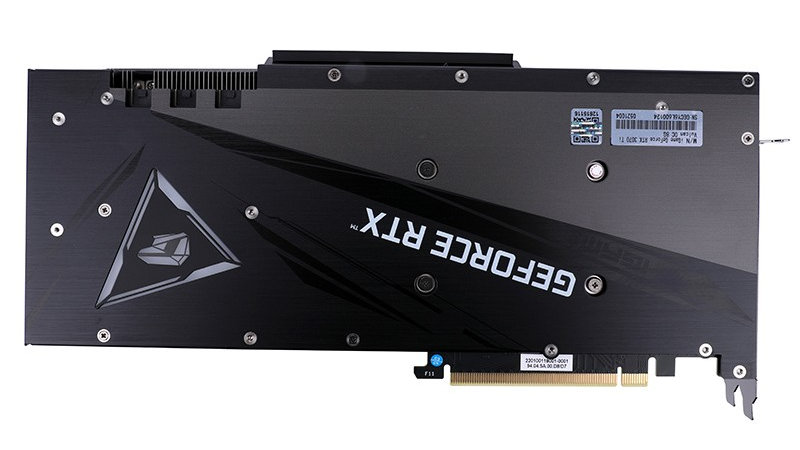
At the top you’ll find the PCIe power connectors, and there are three 8-pin ones to power this card. That seems a bit of an overkill, but presumably this is the case in order to power the attached LCD screen as well as allow for overclockers to push this card a bit further. Colorful is also recommending a minimum 750W PSU to power everything smoothly, so that’s another thing to keep in mind before popping this card into your PC.
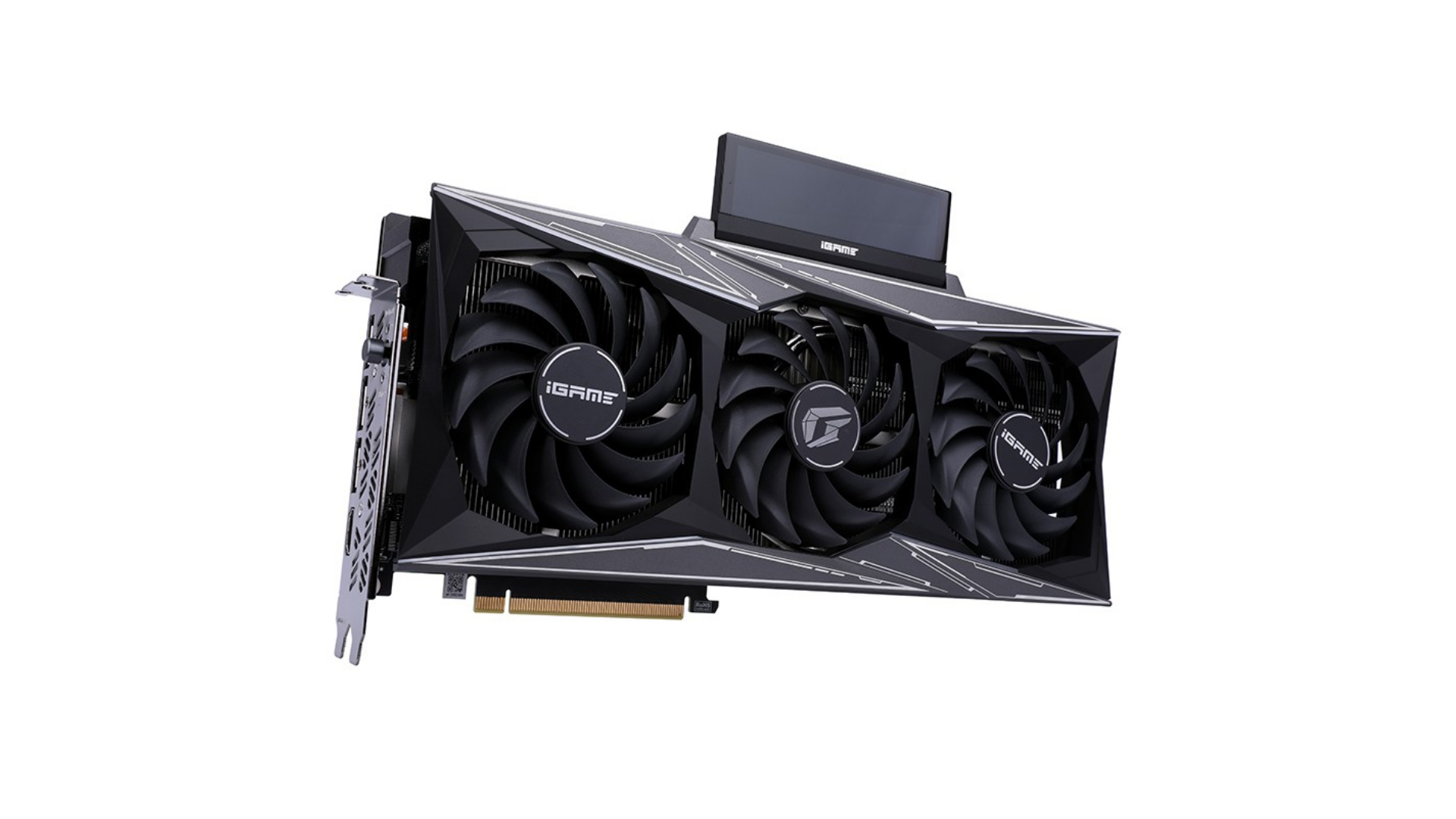
As with the previous generation, there’s also a USB-C port and an RGB header at the back of the card. You can use the included RGB header cable to connect the card directly to your motherboard so that it syncs with the rest of your RGB lighting, while the USB-C port has to be connected to a spare USB header on your motherboard with the included cable. Once you’ve done this, you’ll be able to upload custom artwork and graphics to display on the GPU’s screen.
Speaking of the screen, this is the most unique thing about the iGame RTX 3070 Ti. It can pop up 90 degrees if you’re installing the GPU vertically, and you can also rotate the screen using the included software if you’ve got a more adventurous PC setup. You can use iGame’s control software to display or cycle through various system resources, or just display a graphic on the screen at all times.
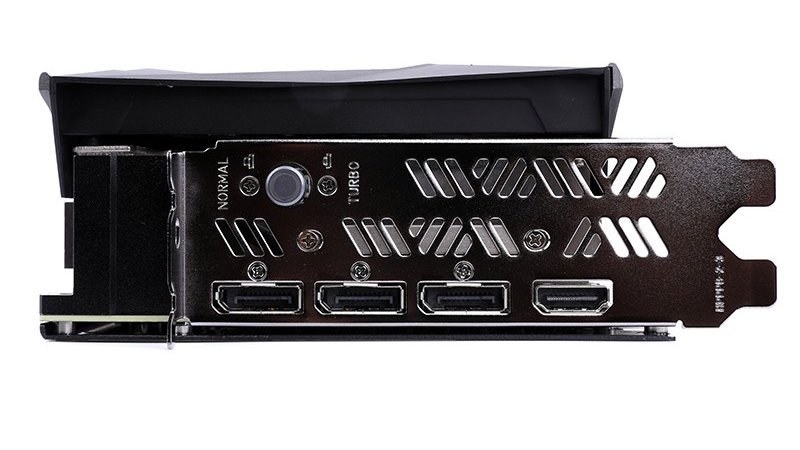
Connectivity-wise, the card features one HDMI 2.1 port and three DisplayPort 1.4 connectors, along with a small button that you can press to overclock the base frequency from 1575MHz to 1860MHz.
Performance
Here's how the iGame RTX 3070 Ti did in our suite of benchmarks:
Fire Strike: 32412
Fire Strike Extreme: 17910
Time Spy: 14170
Time Spy Extreme: 8596
Total War: Three Kingdoms (1080p): 127fps
Destiny 2 (1080p): 144fps
Final Fantasy XIV Benchmark (1080p): 206fps
Assassin’s Creed: Odyssey (1440p): 80fps
Starting with 1080p gaming, the iGame RTX 3070 Ti performed exceptionally well. In games like Destiny 2 and Total War: Three Kingdoms, we regularly had 120-146fps throughout, while Final Fantasy XIV showed a whopping 206fps during its benchmark. There’s enough power here to easily tackle 1080p gaming – perhaps too much power, but even at the highest settings with other visual effects turned on, most games performed flawlessly and didn’t dip below 80fps.
For 1440p gaming performance was still quite strong, jumping between 75-85fps for games like Assassin’s Creed: Odyssey. Where the card starts to strain a little bit – and rightfully so – is when you crank things up to 4K resolution. Again, depending on the game you’re playing and what visual effects are turned on, you’ll looking at around 32-51fps overall. That’s still quite respectable for a card like this, and while you’re not going to get performance figures like those you’d enjoy with an RTX 3080, the iGame RTX 3070 Ti still manages to perform admirably during our 4K gaming sessions. Whether or not you'll actually enjoy playing something at 4K with less than 60fps is entirely up to you.
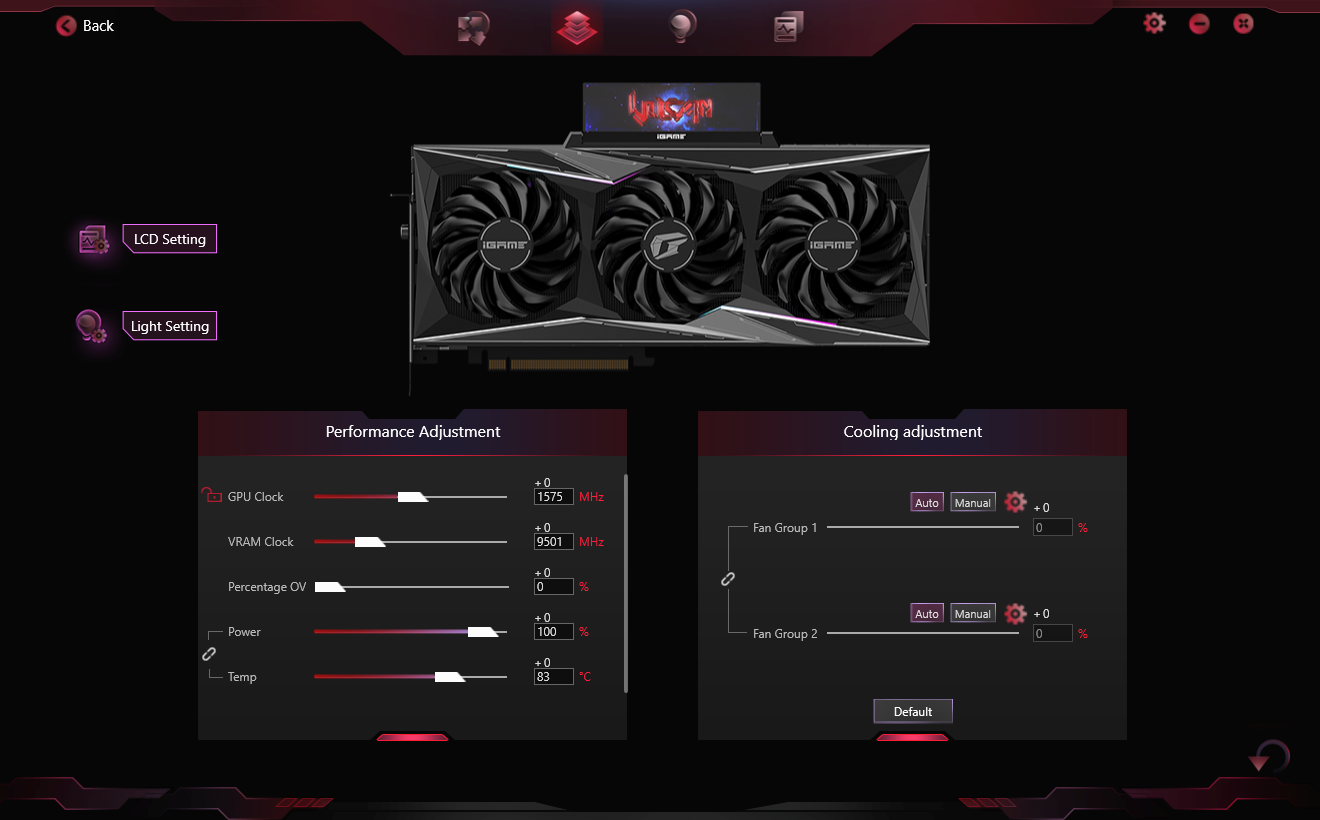
Colorful is also one of the few (if not perhaps, the only) manufacturers to include a dedicated overclocking button on its cards. Pressing this button boost the card’s base frequency from 1575MHz to 1860MHz, allowing you to squeeze out about 8-12fps extra in certain games. It’s not a lot, but the ease of overclocking by just tapping a button is certainly appreciated.
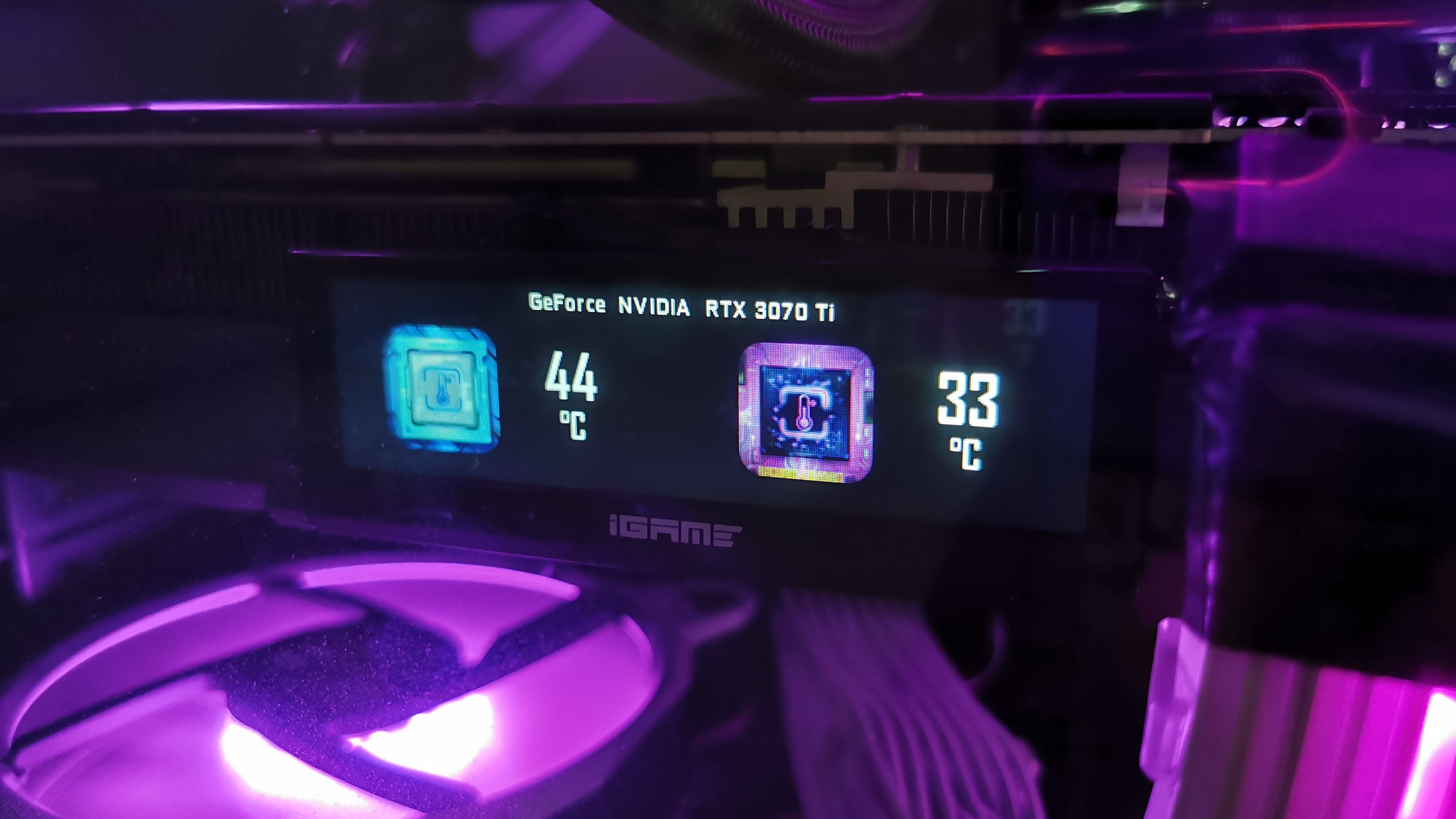
For more invested overclockers, iGame’s control software allows you to tweak your settings more delicately with just a few clicks, making it easy to drill down to the clock settings that you prefer. Standard idle temperatures were around 40C, with the card going up to 72C during longer gaming sessions.
The end result is that the iGame RTX 3070 Ti is a great card for gaming, but its asking price is a bit of a worry. While it’s great for 1080p and 1440p gaming, gamers might find themselves holding back to splurge on RTX 3080 cards when they’re more readily available in the market, or opting to forgo the handy LCD screen in order to get a cheaper price. Still, if you’re missing a good GPU in your PC and you’ve got the money ready to burn, then this is definitely a card worth showing off in your rig.
Buy it if…
You’re in the market for a new GPU now
The Colorful iGame RTX 3070 Ti does 1080p and 1440p gaming very well, and if you don’t mind a pricey GPU upgrade, this is a great card to go with.
You want a unique GPU
Forget RGB lighting – how many GPUs have a screen attached to them? This small add-on actually comes in handy to easily monitor component temperatures – or just display some great artwork.
You’re not looking at 4K gaming
The numbers speak for themselves – 4K gaming is out of reach for this GPU, so if you don’t really care about going any higher than 1440p, then this GPU is more than sufficient.
Don’t buy it if…
You’re on a tight budget
GPUs are already overpriced due to shortages, so the $899 asking price can really be a hard pill to swallow here.
You’ve got a weak PSU
The iGame RTX 3070 Ti is no joke when it comes to performance, so if you’ve got a PSU that’s less than 750W, you’ll need to upgrade that too.
You can splurge for an RTX 3080
If you can save a bit more and get an RTX 3080, you’ll enjoy much stronger performance across all your games, and can even dabble in the realm of 4K gaming.
0 comments:
Post a Comment